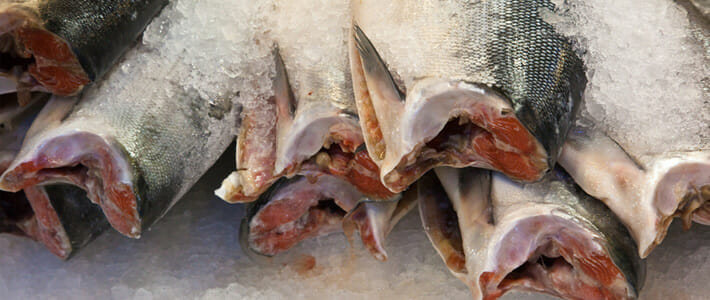Salmon, Sockeye
Oncorhynchus nerka

The name sockeye comes from a poor attempt to translate the word suk-kegh from British Columbia’s native Coast Salish language. Sockeye salmon is the third most common Pacific salmon species. The sockeye, also called red or blueback salmon, is among the smaller of the seven Pacific salmon species, but their succulent, bright-orange meat is prized above all others. They range in size from 24 to 33 inches (60 to 84 centimeters) in length and weigh between 5 and 15 pounds (2.3 to 7 kilograms). Like all other Pacific salmon, they are born in fresh water. However, sockeye require a lake nearby in which to rear. Once hatched, juvenile sockeyes will stay in their natal habitat for up to three years, more than any other salmon. They then journey out to sea, where they grow rapidly, feeding mainly on zooplankton. They stay in the ocean for one to four years. Sockeye are blue tinged with silver while living in the ocean. Just prior to spawning, both sexes turn red with green heads and sport a dark stripe on their sides. Males develop a hump on their back. The jaws and teeth become hooked in freshwater; this hook is known as a kype and is used for fighting other males.
Product pdf for download-
3.5 oz (100g) raw edible portion
-
Calories 168
-
Total Fat 8.56g
-
Saturated Fat 1.495g
-
Cholesterol 62mg
-
Sodium 47mg
-
Carbohydrates 0g
-
Protein 21.3g
-
Selenium 33.7mcg
-
Omega 1200mg
Alternatives
Another wild salmon (coho, Chinook, etc.).
Source
Sockeyes are the third most abundant of the species of Pacific salmon and are a keystone in the North American commercial fisheries. They can be caught anywhere from Hokkaido in Japan to the Columbia River in Oregon, but most are caught in Bristol Bay, Alaska. Sockeyes from the Copper River are especially prized.
Harvest Method
Sockeye salmon are primarily caught with nets, with some hook and line (trolling) as well. These fisheries generally operate in the water column with minimal impact on the bottom or other habitat.
Harvest Season
Available fresh from June to July.
Spawning Season
Sockeye salmon typically spawn in the summer or fall.
Flavor
Sockeyes are very full-flavored, almost strong, and their flavor is faintly crab-like.
Texture
Firm texture.
Preparation
Sockeye salmon demands to be eaten as is. Cook it in a way that highlights its assertive flavor, or eat it raw. Its high oil content makes it a prime candidate for grilling, broiling, roasting, poaching, baking, and smoking.
Market Segments
This fish is appropriate for casual dining, fine dining, hotels, and resort/club markets.